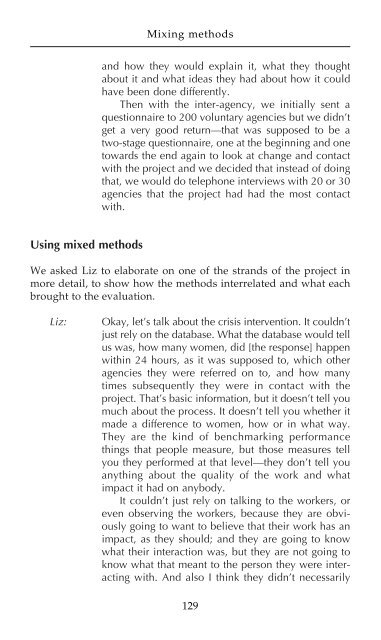Qualitative Research in Practice : Stories From the Field - Blogs Unpad
Qualitative Research in Practice : Stories From the Field - Blogs Unpad
Qualitative Research in Practice : Stories From the Field - Blogs Unpad
Create successful ePaper yourself
Turn your PDF publications into a flip-book with our unique Google optimized e-Paper software.
Mix<strong>in</strong>g methods<br />
and how <strong>the</strong>y would expla<strong>in</strong> it, what <strong>the</strong>y thought<br />
about it and what ideas <strong>the</strong>y had about how it could<br />
have been done differently.<br />
Then with <strong>the</strong> <strong>in</strong>ter-agency, we <strong>in</strong>itially sent a<br />
questionnaire to 200 voluntary agencies but we didn’t<br />
get a very good return—that was supposed to be a<br />
two-stage questionnaire, one at <strong>the</strong> beg<strong>in</strong>n<strong>in</strong>g and one<br />
towards <strong>the</strong> end aga<strong>in</strong> to look at change and contact<br />
with <strong>the</strong> project and we decided that <strong>in</strong>stead of do<strong>in</strong>g<br />
that, we would do telephone <strong>in</strong>terviews with 20 or 30<br />
agencies that <strong>the</strong> project had had <strong>the</strong> most contact<br />
with.<br />
Us<strong>in</strong>g mixed methods<br />
We asked Liz to elaborate on one of <strong>the</strong> strands of <strong>the</strong> project <strong>in</strong><br />
more detail, to show how <strong>the</strong> methods <strong>in</strong>terrelated and what each<br />
brought to <strong>the</strong> evaluation.<br />
Liz:<br />
Okay, let’s talk about <strong>the</strong> crisis <strong>in</strong>tervention. It couldn’t<br />
just rely on <strong>the</strong> database. What <strong>the</strong> database would tell<br />
us was, how many women, did [<strong>the</strong> response] happen<br />
with<strong>in</strong> 24 hours, as it was supposed to, which o<strong>the</strong>r<br />
agencies <strong>the</strong>y were referred on to, and how many<br />
times subsequently <strong>the</strong>y were <strong>in</strong> contact with <strong>the</strong><br />
project. That’s basic <strong>in</strong>formation, but it doesn’t tell you<br />
much about <strong>the</strong> process. It doesn’t tell you whe<strong>the</strong>r it<br />
made a difference to women, how or <strong>in</strong> what way.<br />
They are <strong>the</strong> k<strong>in</strong>d of benchmark<strong>in</strong>g performance<br />
th<strong>in</strong>gs that people measure, but those measures tell<br />
you <strong>the</strong>y performed at that level—<strong>the</strong>y don’t tell you<br />
anyth<strong>in</strong>g about <strong>the</strong> quality of <strong>the</strong> work and what<br />
impact it had on anybody.<br />
It couldn’t just rely on talk<strong>in</strong>g to <strong>the</strong> workers, or<br />
even observ<strong>in</strong>g <strong>the</strong> workers, because <strong>the</strong>y are obviously<br />
go<strong>in</strong>g to want to believe that <strong>the</strong>ir work has an<br />
impact, as <strong>the</strong>y should; and <strong>the</strong>y are go<strong>in</strong>g to know<br />
what <strong>the</strong>ir <strong>in</strong>teraction was, but <strong>the</strong>y are not go<strong>in</strong>g to<br />
know what that meant to <strong>the</strong> person <strong>the</strong>y were <strong>in</strong>teract<strong>in</strong>g<br />
with. And also I th<strong>in</strong>k <strong>the</strong>y didn’t necessarily<br />
129

















